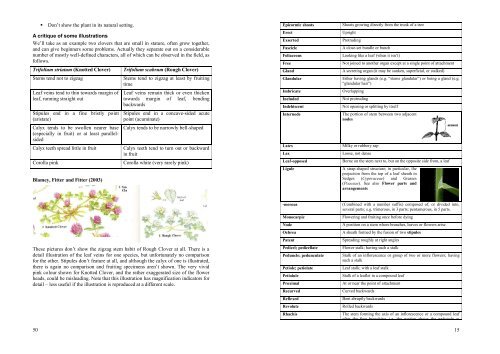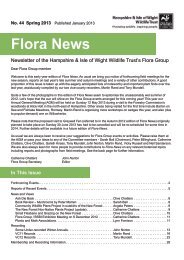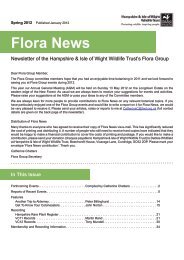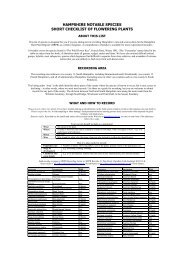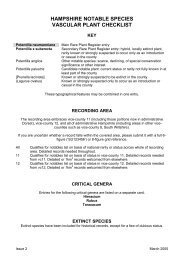An A5 booklet version as distributed in the - Hants Plants
An A5 booklet version as distributed in the - Hants Plants
An A5 booklet version as distributed in the - Hants Plants
You also want an ePaper? Increase the reach of your titles
YUMPU automatically turns print PDFs into web optimized ePapers that Google loves.
50<br />
Don’t show <strong>the</strong> plant <strong>in</strong> its natural sett<strong>in</strong>g.<br />
A critique of some illustrations<br />
We’ll take <strong>as</strong> an example two clovers that are small <strong>in</strong> stature, often grow toge<strong>the</strong>r,<br />
and can give beg<strong>in</strong>ners some problems. Actually <strong>the</strong>y separate out on a considerable<br />
number of mostly well-def<strong>in</strong>ed characters, all of which can be observed <strong>in</strong> <strong>the</strong> field, <strong>as</strong><br />
follows.<br />
Trifolium striatum (Knotted Clover) Trifolium scabrum (Rough Clover)<br />
Stems tend not to zigzag Stems tend to zigzag at le<strong>as</strong>t by fruit<strong>in</strong>g<br />
time<br />
Leaf ve<strong>in</strong>s tend to th<strong>in</strong> towards marg<strong>in</strong> of<br />
leaf, runn<strong>in</strong>g straight out<br />
Stipules end <strong>in</strong> a f<strong>in</strong>e bristly po<strong>in</strong>t<br />
(aristate)<br />
Calyx tends to be swollen nearer b<strong>as</strong>e<br />
(especially <strong>in</strong> fruit) or at le<strong>as</strong>t parallelsided<br />
Leaf ve<strong>in</strong>s rema<strong>in</strong> thick or even thicken<br />
towards marg<strong>in</strong> of leaf, bend<strong>in</strong>g<br />
backwards<br />
Stipules end <strong>in</strong> a concave-sided acute<br />
po<strong>in</strong>t (acum<strong>in</strong>ate)<br />
Calyx tends to be narrowly bell-shaped<br />
Calyx teeth spread little <strong>in</strong> fruit Calyx teeth tend to turn out or backward<br />
<strong>in</strong> fruit<br />
Corolla p<strong>in</strong>k Corolla white (very rarely p<strong>in</strong>k)<br />
Blamey, Fitter and Fitter (2003)<br />
These pictures don’t show <strong>the</strong> zigzag stem habit of Rough Clover at all. There is a<br />
detail illustration of <strong>the</strong> leaf ve<strong>in</strong>s for one species, but unfortunately no comparison<br />
for <strong>the</strong> o<strong>the</strong>r. Stipules don’t feature at all, and although <strong>the</strong> calyx of one is illustrated,<br />
<strong>the</strong>re is aga<strong>in</strong> no comparison and fruit<strong>in</strong>g specimens aren’t shown. The very vivid<br />
p<strong>in</strong>k colour shown for Knotted Clover, and <strong>the</strong> ra<strong>the</strong>r exaggerated size of <strong>the</strong> flower<br />
heads, could be mislead<strong>in</strong>g. Note that this illustration h<strong>as</strong> magnification <strong>in</strong>dicators for<br />
detail – less useful if <strong>the</strong> illustration is reproduced at a different scale.<br />
Epicormic shoots Shoots grow<strong>in</strong>g directly from <strong>the</strong> trunk of a tree<br />
Erect Upright<br />
Exserted Protrud<strong>in</strong>g<br />
F<strong>as</strong>cicle A close-set bundle or bunch<br />
Foliaceous Look<strong>in</strong>g like a leaf (when it isn’t)<br />
Free Not jo<strong>in</strong>ed to ano<strong>the</strong>r organ except at a s<strong>in</strong>gle po<strong>in</strong>t of attachment<br />
Gland A secret<strong>in</strong>g organ (it may be sunken, superficial, or stalked)<br />
Glandular Ei<strong>the</strong>r hav<strong>in</strong>g glands (e.g. “stems glandular”) or be<strong>in</strong>g a gland (e.g.<br />
“glandular hair”)<br />
Imbricate Overlapp<strong>in</strong>g<br />
Included Not protrud<strong>in</strong>g<br />
Indehiscent Not open<strong>in</strong>g or splitt<strong>in</strong>g by itself<br />
Internode The portion of stem between two adjacent<br />
nodes<br />
Latex Milky or rubbery sap<br />
Lax Loose, not dense<br />
Leaf-opposed Borne on <strong>the</strong> stem next to, but on <strong>the</strong> opposite side from, a leaf<br />
Ligule A strap-shaped structure; <strong>in</strong> particular, <strong>the</strong><br />
projection from <strong>the</strong> top of a leaf sheath <strong>in</strong><br />
Sedges (Cyperaceae) and Gr<strong>as</strong>ses<br />
(Poaceae). See also Flower parts and<br />
arrangements<br />
-merous (Comb<strong>in</strong>ed with a number suffix) composed of, or divided <strong>in</strong>to,<br />
several parts; e.g. trimerous, <strong>in</strong> 3 parts; pentamerous, <strong>in</strong> 5 parts.<br />
Monocarpic Flower<strong>in</strong>g and fruit<strong>in</strong>g once before dy<strong>in</strong>g<br />
Node A position on a stem where branches, leaves or flowers arise<br />
Ochrea A sheath formed by <strong>the</strong> fusion of two stipules<br />
Patent Spread<strong>in</strong>g roughly at right angles<br />
Pedicel; pedicellate Flower stalk; hav<strong>in</strong>g such a stalk<br />
Peduncle; pedunculate Stalk of an <strong>in</strong>florescence or group of two or more flowers; hav<strong>in</strong>g<br />
such a stalk<br />
Petiole; petiolate Leaf stalk; with a leaf stalk<br />
Petiolule Stalk of a leaflet <strong>in</strong> a compound leaf<br />
Proximal At or near <strong>the</strong> po<strong>in</strong>t of attachment<br />
Recurved Curved backwards<br />
Reflexed Bent abruptly backwards<br />
Revolute Rolled backwards<br />
Rhachis The stem form<strong>in</strong>g <strong>the</strong> axis of an <strong>in</strong>florescence or a compound leaf<br />
after <strong>the</strong> first branch<strong>in</strong>g, i.e. <strong>the</strong> portion above <strong>the</strong> peduncle or<br />
15


